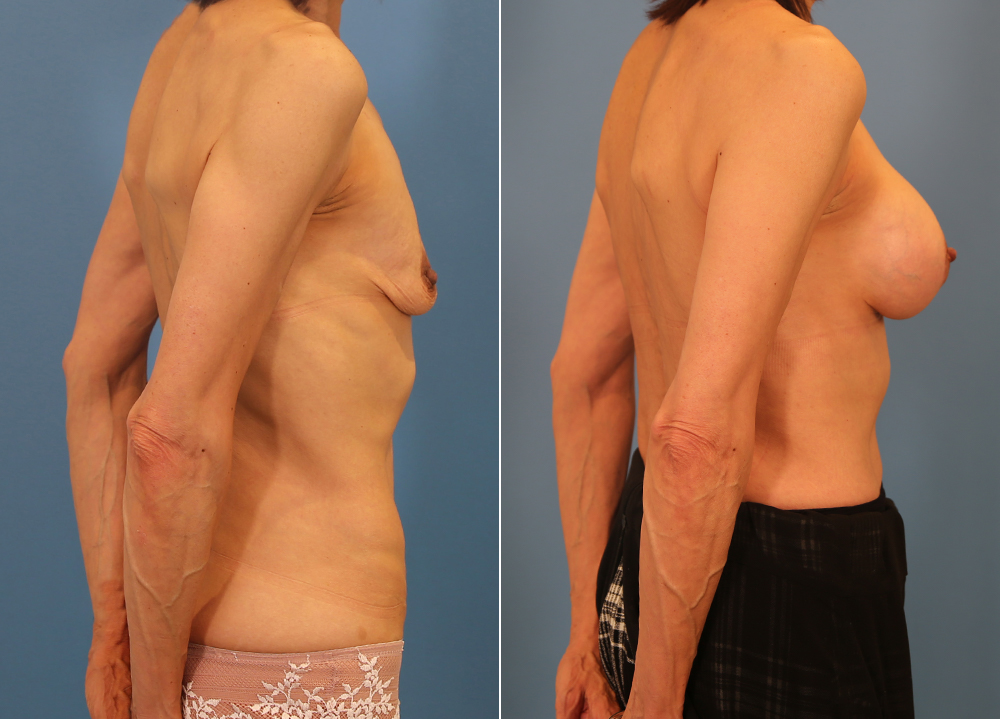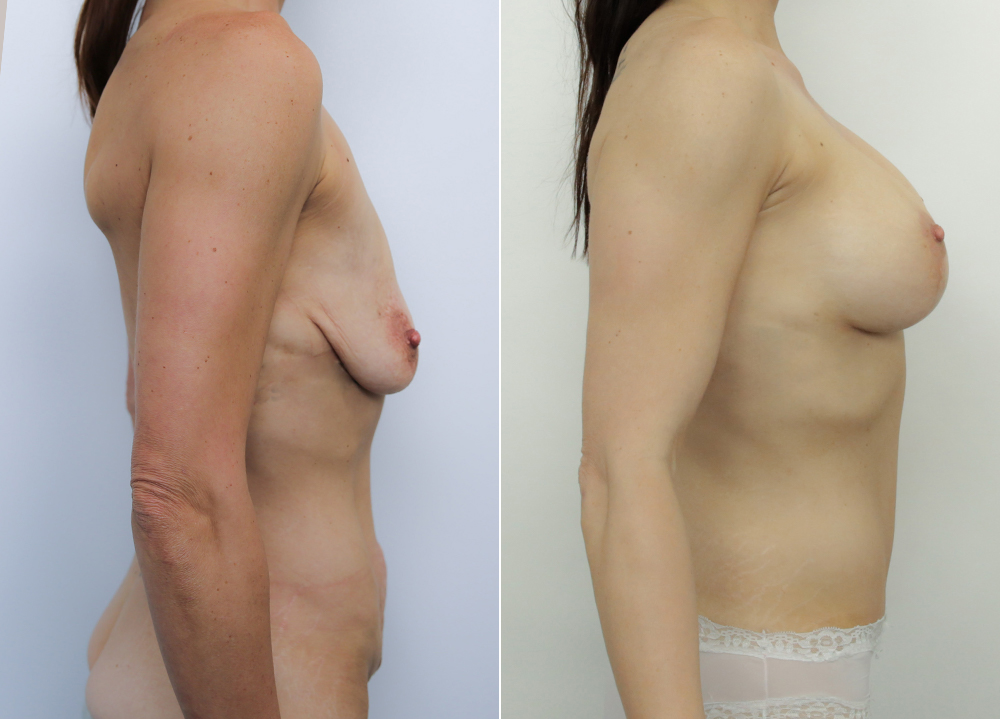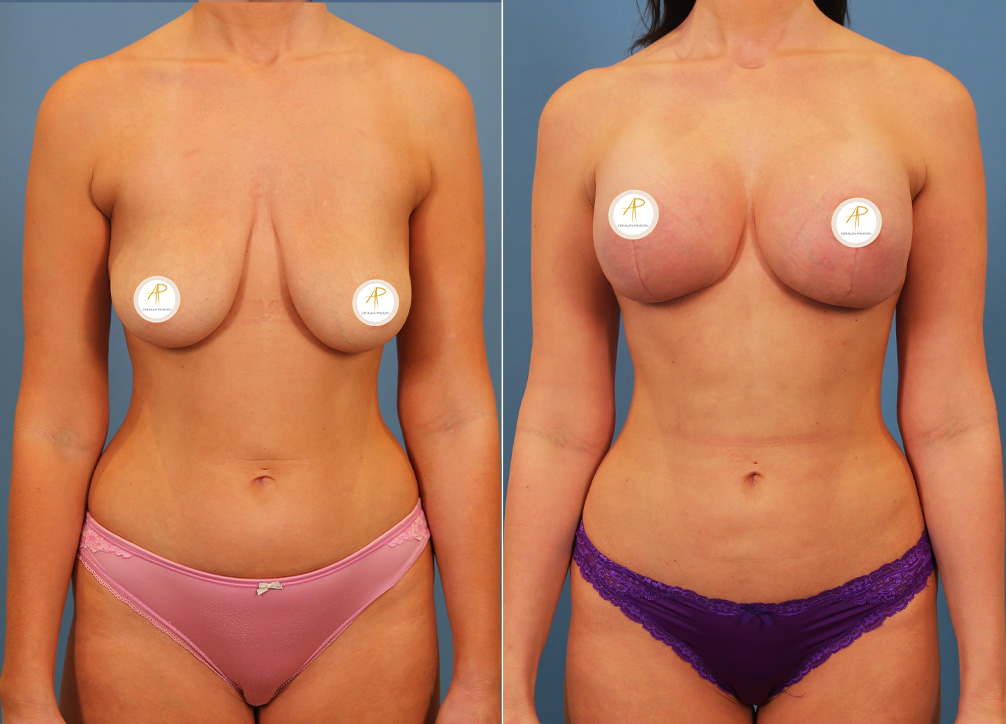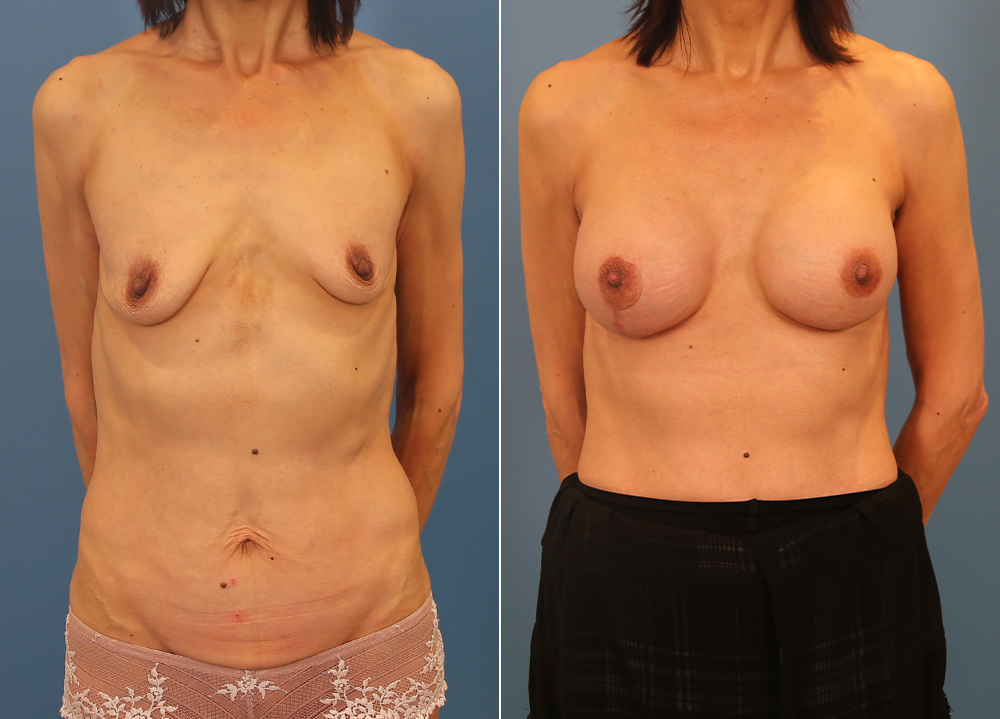WHAT IS A BREAST AUGMENTATION MASTOPEXY?



WHAT IS A BREAST AUGMENTATION MASTOPEXY?
A breast augmentation mastopexy, also known as a breast lift with implants, is a surgical procedure that combines breast augmentation and breast mastopexy (breast lift) techniques. It is designed to improve the size, shape, and position of the breasts, giving them a more balanced appearance. Losing breast volume is a normal part of the aging process and is particularly common after having children and following weight loss. The procedure involves addressing issues such as sagging (ptosis) of the breasts by removing excess skin, reshaping the breast tissue and surgically repositioning the nipple, while simultaneously inserting breast implants to enhance the size and fullness of the breasts. Whilst the operation is usually performed in a single stage, it sometimes may need to be performed in two stages, particularly with patients who have had massive weight loss. During a breast augmentation mastopexy, Dr Phoon will customize the procedure to meet your unique needs and aesthetic goals. This tailored approach ensures that the results are natural-looking and harmonious with your body proportions.
HOW DO YOU DETERMINE IF I NEED A BREAST AUGMENTATION MASTOPEXY OR A BREAST AUGMENTATION ALONE?



HOW DO YOU DETERMINE IF I NEED A BREAST AUGMENTATION MASTOPEXY OR A BREAST AUGMENTATION ALONE?
There are many factors that influence this decision, but perhaps the most important is the position of the nipple relative to the crease under your breast. In general terms, if the nipple is well below the crease, you usually need a lift with an implant. If the nipple is at the level of the crease, sometimes the right-sized implant will lift things enough without a lift. If the nipple is above the crease, usually an implant alone will work. Factors such as breast asymmetry or the desire for a very modest implant might tip the balance in favour of performing a breast augmentation mastopexy.
TYPES OF BREAST AUGMENTATION MASTOPEXY
Sample text sample text sample text sample
Lorem ipsum dolor sit amet, consectetur adipiscing elit, sed do eiusmod tempor incididunt ut labore et dolore magna aliqua. Quis ipsum suspendisse ultrices gravida. Risus commodo viverra maecenas accumsan lacus vel facilisis. Lorem ipsum dolor sit amet, consectetur adipiscing elit, sed do eiusmod tempor incididunt ut labore et dolore magna aliqua. Quis ipsum suspendisse ultrices gravida. Risus commodo viverra maecenas accumsan lacus vel facilisis. Lorem ipsum dolor sit amet, consectetur adipiscing elit,
FREQUENTLY ASKED QUESTIONS ABOUT OUR BREAST MASTOPEXY PROCEDURES
Every breast augmentation mastopexy (breast lift with implants) procedure involves surgical incisions which result in scars on the breast.
Moving the nipple from a low position to a higher position always means a circumferential scar around the nipple and areolar and a vertical incision that drops below it. This is called a lollipop incision. This is often combined with a small incision in the crease under the breast which is used to place the implant prior to the lift. This horizontal incision is the same type that patients have when having a breast augmentation and is the least visible of all the incisions, as it is hidden in the breast crease. If you have low-hanging breasts, then this lower crease incision will need to be longer to remove the extra skin. This incision is called an anchor or inverted T incision.
All scars will fade with time and post-operative scar management involving silicon tapes and gel will help with the scar healing process.
This is a common question for patients who are used to having exercise as a normal part of their daily activities. After having a breast augmentation mastopexy (breast lift with implants) you may do light walking after 2 weeks, but you need to wait a full six weeks after surgery to return to more vigorous exercise to minimise the risk of implant movement and to allow yourself time to heal. It is important to wear your post-operative bra for 6 weeks post-op, and to always wear supportive bras whilst exercising following the initial post-operative period. Always listen to your body, and if in doubt ask myself or my practice nurse for advice.
The most common procedure combined with a breast augmentation mastopexy (breast lift with implants) requested by patients is a tummy procedure such as an abdominoplasty. Like the breast, the abdominal area undergoes a remarkable amount of change following pregnancy or massive weight loss. I do not like the “makeover” terminology commonly used in reference to surgery after having children, as I feel mums don’t need “makeovers.” The changes you go through to have kids are amazing. If you’ve achieved your ideal weight after weight loss or after having kids and you feel that you want to do something about your shape or excess skin, then I can help. I perform many of these combined procedures and feel it is a privilege for me to do so.
A breast augmentation mastopexy (breast lift with implants) is usually a day surgical procedure, unless it is combined with another procedure such as an abdominoplasty.
It is advised to take 1-2 weeks off from work (depending on your occupation). The first 3-4 days are the most uncomfortable, so we give you a range of pain relief medications to help keep you comfortable. We’re always on hand to help assist with any questions or concerns during your recovery. You can expect to be swollen for the first few weeks, and it takes between 6-8 weeks until you can get a good idea of your final result. Results and recovery will vary between patients.
Risks and complications of cosmetic surgery
Cosmetic surgery is still surgery and as such always has potential risks and complication. It is important for anyone considering cosmetic surgery to be well-informed and aware of the possible adverse outcomes. Dr Alex Phoon is a fully qualified Australian specialist plastic and cosmetic surgeon who operates with an experienced team in leading public and private hospitals in Sydney Australia.
In this article, we will dive into the various risks and complications associated with cosmetic surgery, providing insights into each aspect.
Scarring
One of the most common concerns among patients undergoing cosmetic surgery is the potential for scarring. While skilled surgeons strive to minimize scarring, it is an inevitable part of the healing process.
Read moreThe severity of scarring varies depending on the individual and the procedure performed. Certain factors, such as genetics and skin type, can also influence how prominent scars may be. However, it is worth noting that in many cases, scars fade over time and can be further improved through scar revision techniques.
Scarring is a natural part of the body’s healing process. When the skin is injured, whether through surgery or trauma, the body responds by forming new collagen fibres to repair the damage. This process can result in the formation of a scar, which is a visible mark on the skin that differs in texture and colour from the surrounding tissue.
There are different types of scars that can occur after cosmetic surgery. One common type is a hypertrophic scar, which is characterized by raised and thickened tissue. These scars may be red or pink in colour and can be itchy or uncomfortable. Another type of scar is a keloid, which is an overgrowth of scar tissue that extends beyond the boundaries of the original wound. Keloids are more common in individuals with darker skin tones and can be more challenging to treat.
Fortunately, advancements in surgical techniques and post-operative care have greatly improved the management of scars. Surgeons take great care in placing incisions in inconspicuous areas and using techniques to minimize tension on the wound, which can help reduce the risk of visible scarring. Additionally, patients are often advised to follow a specific scar care regimen, which may include keeping the incision site clean, applying silicone gel or sheets, and avoiding sun exposure.
In some cases, scar revision techniques may be recommended to further improve the appearance of scars. These techniques can include laser resurfacing, dermabrasion, or surgical excision. Laser resurfacing uses a laser to remove the top layers of the skin, promoting the growth of new, healthier skin cells. Dermabrasion involves using a rotating brush or diamond wheel to gently remove the outer layers of the skin, revealing smoother skin underneath. Surgical excision involves removing the scar tissue and rejoining the edges of the skin to create a more aesthetically pleasing scar.
It is important for patients to have realistic expectations when it comes to scarring. While surgeons strive to minimize scarring, it is impossible to eliminate it. However, with proper care and the use of scar revision techniques, the appearance of scars can be significantly improved. Patients should discuss their concerns and expectations with their surgeon prior to undergoing any cosmetic procedure to ensure they have a clear understanding of the potential for scarring and the available treatment options.
Infection
Infections are another risk associated with any surgical procedure, including cosmetic surgery. Despite stringent sterilization protocols followed by healthcare professionals, there is still a possibility of infection.
Read moreTo mitigate this risk, surgeons prescribe antibiotics pre- and post-surgery, adhere to aseptic techniques, and closely monitor patients for signs of infection. It is crucial for patients to follow their surgeon’s aftercare instructions to minimize the risk of infection.
When it comes to cosmetic surgery, infection is a concern that cannot be ignored. Surgical procedures, no matter how minor, create an entry point for bacteria and other microorganisms. Although healthcare professionals take every precaution to maintain a sterile environment, the human body is naturally teeming with bacteria, making it impossible to eliminate the risk entirely.
Fortunately, surgeons are aware of this risk and take proactive measures to minimize the chances of infection. One such measure is the prescription of antibiotics. Prior to surgery, patients are often given a course of antibiotics to help prevent any potential infection from taking hold. These antibiotics are carefully chosen based on the patient’s medical history and the specific procedure being performed.
Post-surgery, patients are usually required to continue taking antibiotics for a certain period. This helps to ensure that any bacteria that may have entered the body during the procedure are promptly eradicated. By adhering to the prescribed antibiotic regimen, patients can significantly reduce the risk of developing an infection.
In addition to antibiotics, surgeons also follow strict aseptic techniques during the surgical procedure itself. This involves maintaining a sterile environment, using sterile instruments and equipment, and wearing appropriate protective clothing, such as gloves and masks. These precautions help to minimize the introduction of bacteria into the surgical site, further reducing the risk of infection.
Despite these measures, it is important to note that infections can still occur. The human body is a complex system, and sometimes even the most stringent precautions cannot completely eliminate the risk. However, by closely monitoring patients for signs of infection, surgeons can detect and treat any potential infections early on, preventing them from becoming serious complications.
Patients also play a crucial role in minimizing the risk of infection. Following the surgeon’s aftercare instructions is of utmost importance. This may include keeping the surgical site clean and dry, avoiding certain activities or behaviours that could increase the risk of infection, and promptly reporting any signs of infection, such as redness, swelling, or discharge.
In conclusion, while the risk of infection is present in any surgical procedure, including cosmetic surgery, healthcare professionals take numerous precautions to minimize this risk. From prescribing antibiotics to following aseptic techniques, surgeons prioritize patient safety and strive to create the best possible outcome. However, it is essential for patients to actively participate in their own aftercare and follow the instructions provided by their surgeon to further reduce the risk of infection.
Pain
Pain and discomfort is a common experience following cosmetic surgery but can be mitigated with modern analgesic strategies.
Read moreThe extent of pain can vary depending on the procedure, the individual’s pain tolerance, and the body’s healing response. Surgeons typically prescribe pain medications to manage any discomfort during the recovery period. It is important for patients to communicate their pain levels with their healthcare providers, as proper pain management is crucial for a smooth recovery.
Undesirable cosmetic outcome
While cosmetic surgery aims to enhance aesthetics, there is always a risk of an undesirable cosmetic outcome.
Read moreFactors such as unrealistic expectations and the biological unpredictability of healing can contribute to suboptimal results. It is essential for patients to have open and honest discussions with their surgeons about their desired outcomes, potential limitations, and realistic expectations. This helps ensure that both parties are on the same page and reduces the chances of disappointment. Revision surgery might be an option should this be an issue.
Nerve damage
Another potential complication of cosmetic surgery is nerve damage.
Read moreSurgeons take great care to avoid damaging nerves during procedures, but it is not always possible to eliminate this risk entirely. Nerve damage can cause numbness, tingling, or loss of sensation in the operated area. In most cases, nerve function gradually improves, but it may take some time for complete resolution. Patients should be aware of this potential risk and discuss it with their surgeon before proceeding with the surgery.
Bruising and swelling
Bruising and swelling are common after cosmetic surgery, particularly in the early stages of recovery.
Read moreThese symptoms are part of the body’s natural response to trauma. Surgeons may recommend compression garments, elevation, and cold compresses to help minimize these effects. While bruising and swelling are temporary, they can cause discomfort and can affect the recovery timeline. Patience and adherence to post-operative guidelines can aid in reducing the duration and severity of these side effects.
Bleeding
Bleeding during or after surgery is a potential complication that can occur in any surgical procedure, including cosmetic surgery.
Read moreSurgeons take measures to control bleeding during the operation, but occasionally, some post-operative bleeding may occur. It is crucial for patients to inform their healthcare providers if they experience excessive bleeding or if they are unable to control bleeding with gentle pressure. Immediate medical attention is necessary to address this complication. If there is major bleeding, you might require a blood transfer or transfer to a hospital for additional treatment.
Seroma
A seroma is a pocket of fluid that can accumulate under the skin after surgery.
Read moreIt forms as a result of the body’s inflammatory response. Seromas are more common in larger surgical procedures and can lead to swelling and discomfort. Surgeons may drain seromas through aspiration or place drains to prevent their accumulation. A surgical drain can be used to minimise this risk. Close monitoring by healthcare providers is crucial to ensure the timely detection and management of seromas.
Anaesthetic complications
Although rare, complications related to anaesthesia can occur during cosmetic surgery.
Read moreAnaesthesia is administered to ensure patient comfort and safety during the procedure. Factors such as individual reactions, allergies, or underlying health conditions can increase the risk of complications. Anaesthetists are highly trained professionals who monitor patients closely throughout the surgery to minimize any potential risks.
Death
While the risk of death from cosmetic surgery is extremely low, it is essential to acknowledge that any surgical procedure carries inherent risks.
Read moreEvery effort is made to prioritize patient safety and ensure favourable outcomes. The preoperative assessment, careful surgical planning, and adherence to appropriate protocols help minimize this risk. Patients should discuss their specific concerns with their surgical team and feel confident in the expertise and experience of their chosen surgeon.
In conclusion, cosmetic surgery offers individuals an opportunity to enhance their appearance, but it is essential to recognize that it is not without its risks and complications. By understanding and discussing these potential outcomes with their surgeons, patients can make informed decisions and take necessary precautions to optimize their safety and overall surgical experience. With proper expectations, diligent aftercare, and open communication, the risks associated with cosmetic surgery can be minimized, and the goal of achieving desired aesthetic improvements can be realized.












